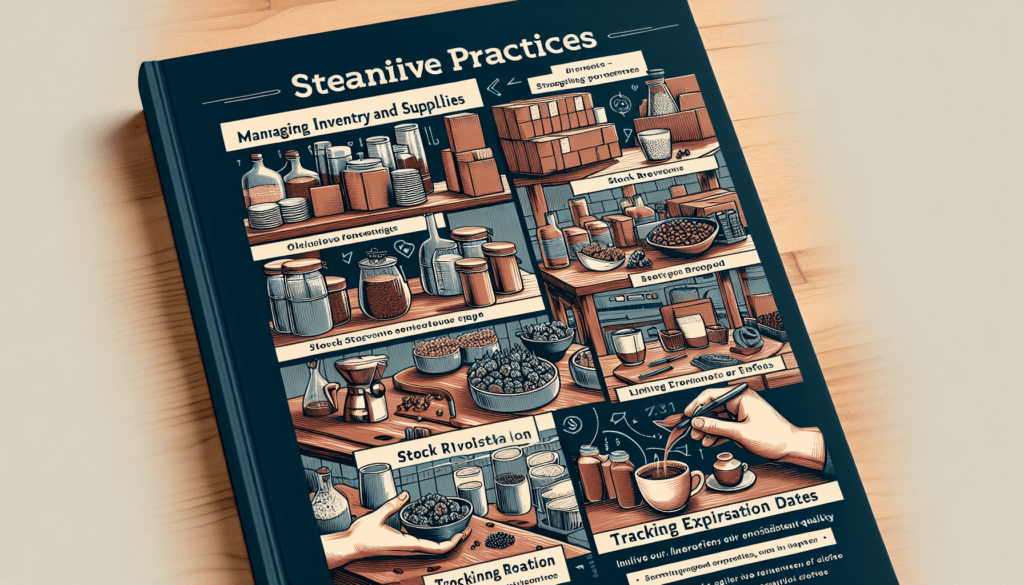Running a successful coffee shop requires more than just serving up great cups of joe. It also means effectively managing your inventory and supplies to ensure you have everything you need to keep the coffee flowing. In this article, we will explore the best practices for managing inventory and supplies in a coffee shop, providing you with valuable tips and insights to help streamline your operations and maximize efficiency. So grab a latte and get ready to learn the secrets to running a well-stocked and organized coffee shop.

Importance of Managing Inventory and Supplies
Managing inventory and supplies is crucial for the success of any coffee shop. By effectively managing these resources, you can ensure that you always have the necessary products on hand, minimize waste and loss, and maximize profitability. Without a proper inventory management system in place, you may encounter issues such as overstocking, stockouts, expired products, and difficulties in reordering. To avoid these problems and streamline your operations, it is essential to implement best practices for managing inventory and supplies in your coffee shop.
Setting Up an Effective Inventory Management System
To start, you need to establish an efficient inventory management system for your coffee shop. This system will help you keep track of your stock levels, categorize products, and implement a barcode system for easy identification and tracking.
Determining Inventory Levels
The first step in setting up your inventory management system is determining the appropriate inventory levels for different products. This involves finding the balance between having enough stock to meet customer demand and avoiding excessive stock that may lead to waste or financial strain. By analyzing sales data, seasonal trends, and historical patterns, you can estimate the optimal quantity of each item to keep in stock.
Categorizing Products
Categorizing your products is another important aspect of your inventory management system. By grouping similar items together, you can streamline your storage and organization process as well as identify which products require more attention or frequent monitoring. Common categories in a coffee shop may include coffee beans, flavored syrups, tea, equipment, and non-perishable items.
Implementing a Barcode System
Implementing a barcode system is an efficient way to track and monitor your inventory accurately. By assigning a unique barcode to each product, you can easily scan and update your inventory records, reducing the risk of human error and simplifying the reordering process. Barcode systems also facilitate better tracking of product expiration dates and help identify slow-moving items that may need additional attention.
Proper Storage and Organization
Proper storage and organization are crucial to maintaining the quality and freshness of your inventory. A well-organized storage space and the use of appropriate containers and labels can save you time, minimize waste, and ensure smooth operations.
Designing an Efficient Storage Space
When designing your storage space, consider factors like accessibility, temperature control, and product rotation. Arrange your shelves and storage areas in a logical order, grouping similar products together and placing frequently accessed items within easy reach. Create a system to monitor and regulate the temperature and humidity in your storage area to prevent spoilage. Additionally, develop a clear rotation system to ensure that older products are used first, reducing the risk of expiration.
Using Proper Containers and Labels
Proper containers and labels are essential for maintaining the quality and integrity of your inventory. Use airtight containers for storing coffee beans, tea leaves, and other perishable items to preserve freshness. Clearly label each container with the product name, expiration date, and any other important information to aid in easy identification and tracking. This practice not only helps you maintain an organized storage area but also ensures that products are used before they expire.
Rotating Stock
Rotating stock is crucial to minimize waste and ensure that products are used in the order they are received. By adhering to the first-in, first-out (FIFO) method, you can prevent items from sitting in storage for too long and ensure that older stock is used before newer arrivals. Regularly check your inventory, move older items to the front, and place newer items toward the back to maintain product freshness and reduce the risk of spoilage.
Monitoring and Tracking Inventory
To effectively manage your inventory and supplies, you need to continuously monitor and track your stock levels and consumption patterns. Keeping a close eye on your inventory will enable you to make informed decisions and take proactive measures to prevent stockouts, overstocking, and product waste.
Regular Stocktaking
Regular stocktaking involves physically counting and reconciling your inventory with your records. By conducting accurate and timely stocktakes, preferably on a weekly or monthly basis, you can identify any discrepancies or inaccuracies in your inventory system. This process not only helps rectify any errors but also provides valuable insights into your inventory turnover, allowing you to adjust your purchasing and ordering decisions accordingly.
Utilizing Inventory Management Software
Inventory management software can streamline and automate many aspects of tracking and managing inventory in your coffee shop. These software solutions help you keep track of sales, monitor stock levels, and generate real-time reports, improving overall efficiency and accuracy. With the capability to integrate with other systems like point-of-sale (POS) software and accounting software, inventory management software provides a comprehensive solution for seamless inventory control.
Implementing Effective POS Systems
A robust POS system can greatly contribute to effective inventory management. By integrating your inventory management software with your POS system, you can automatically update stock levels with each transaction, track sales data, and generate reports to identify popular items and analyze sales trends. This integration allows for better inventory planning, ensuring that you always have enough stock to meet customer demand while avoiding excessive overstocking.

Streamlining Ordering and Replenishment Processes
Streamlining your ordering and replenishment processes is essential to avoid stockouts, minimize excess inventory, and maintain a healthy balance between supply and demand. Consider the following best practices to optimize your ordering and replenishment procedures.
Determining Optimal Order Quantities
Determining the optimal order quantities for each product is crucial to efficient inventory management. Striking the right balance between ordering too much and ordering too little requires careful analysis of factors such as customer demand, product shelf life, and lead times from suppliers. By understanding these variables and leveraging your sales data, you can develop a data-driven approach to determine the right order quantities, minimizing waste and optimizing inventory levels.
Establishing Relationships with Trusted Suppliers
Building strong relationships with trusted suppliers is beneficial for your coffee shop in multiple ways. Establishing reliable communication channels and maintaining good rapport with suppliers can ensure timely deliveries, resolve any issues promptly, and even lead to favorable pricing and terms. By fostering mutually beneficial relationships, you can count on your suppliers to provide consistent quality products, reducing the risk of stockouts and enabling efficient inventory management.
Implementing Just-in-Time Inventory
Just-in-time (JIT) inventory management is a strategy that aims to minimize excess inventory by receiving and using supplies just in time for production or sale. By aligning your ordering and replenishment processes closely with your customer demand, you can reduce carrying costs associated with excessive stock, minimize waste due to product expiration, and optimize your cash flow. However, it is vital to establish a reliable and efficient supply chain and have contingency plans in place to handle unexpected fluctuations in demand.
Effective Product Pricing Strategies
Pricing your products appropriately is essential for profitability and managing your inventory effectively. By considering costs, profit margins, and competitor pricing, and implementing regular menu reviews, you can develop effective pricing strategies that maximize revenue while maintaining customer satisfaction.
Considering Costs and Profit Margins
It is crucial to consider both the costs associated with your products and the desired profit margins when setting prices. Take into account factors such as raw material costs, labor costs, overhead expenses, and desired profit levels. Conduct regular cost analyses and determine the optimal pricing structure that ensures profitability while remaining competitive and attractive to customers.
Analyzing Competitor Pricing
Analyzing competitor pricing is a valuable practice to gauge the market and stay competitive. Understand the pricing strategies employed by your competitors, identifying any price gaps or opportunities for differentiation. While it is important to offer competitive prices, ensure that your pricing is sustainable and accounts for the quality and value you provide to your customers.
Implementing Regular Menu Reviews
Regular menu reviews are essential for evaluating the performance of your products and their contribution to your overall profitability. Analyze sales data for each item on your menu, identifying popular items, slow-moving products, and any pricing or margin adjustments that may be necessary. By regularly reviewing and updating your menu, you can ensure that your offerings align with customer preferences, optimize your inventory, and maintain a healthy bottom line.

Managing Waste and Expiry
Managing waste and expiry is critical in any coffee shop to minimize losses, maximize profitability, and maintain quality standards. Implementing proper procedures and practices can help you effectively manage waste and reduce the risk of products reaching their expiration dates unused.
Implementing FIFO Method
The first-in, first-out (FIFO) method is a fundamental practice in inventory management that helps reduce waste and manage expiration dates effectively. By using the oldest items first, you ensure that all products are utilized before they expire, minimizing losses while maintaining quality and freshness. Train your staff to follow the FIFO method consistently and establish clear labeling systems to ensure that products are easily identified and used in the proper order.
Minimizing Food and Beverage Waste
Coffee shops often deal with perishable items, such as pastries, sandwiches, and beverages, which are subject to spoilage and waste. To minimize waste, consider the following practices:
- Implement portion control measures to avoid excessive servings and food waste.
- Monitor and adjust production quantities based on demand and consumption patterns.
- Identify opportunities to repurpose or reuse leftover ingredients to create new menu items or offerings.
- Establish relationships with local food banks or charities to donate excess food that is still safe for consumption.
Tracking Expiry Dates
Vigilantly tracking expiry dates is crucial to avoid serving expired products, maintain quality standards, and reduce waste. Regularly update your inventory records with accurate expiration dates for each product and establish clear systems to identify items nearing their expiry. Train your staff to conduct frequent checks and remove any expired items from storage promptly. Additionally, consider implementing notifications or alerts within your inventory management system to ensure that you are always aware of upcoming expirations.
Employee Training and Communication
Properly training your staff on inventory management procedures and establishing clear communication channels are essential to the success of your inventory control efforts. Engage your employees in the process, make them aware of the importance of inventory management, and provide them with the necessary tools and knowledge to support your efforts.
Educating Staff on Inventory Management
Ensure that all employees, including managers and frontline staff, receive comprehensive training on inventory management practices and procedures. Train them on key topics such as proper product handling, labeling, rotation, waste reduction techniques, and how to use inventory management software effectively. Encourage open communication and provide resources like training manuals, checklists, and reference materials to support continuous learning.
Establishing Clear Communication Channels
Establishing clear lines of communication is vital to ensure that valuable information regarding inventory is shared effectively and promptly among your staff. Encourage open dialogue, feedback, and suggestions from employees regarding inventory management. Regularly communicate changes in procedures, product updates, and any other relevant information that may impact inventory levels or operations. This transparency fosters a sense of ownership and responsibility among your employees and ensures that everyone is aligned and working towards the same goals.
Setting up Systems for Reporting Losses or Shortages
Creating systems for reporting losses or shortages is essential to address any issues quickly and minimize their impact. Encourage your staff to report any discrepancies they encounter during stocktaking or when handling inventory. Establish clear procedures to investigate and address these reports promptly, allowing for timely adjustments, such as reordering or investigating potential theft. A culture of accountability and transparency will go a long way in maintaining accurate inventory records and minimizing losses.

Regular Performance Review and Analysis
Regularly reviewing and analyzing sales and inventory reports is essential to identify trends, patterns, and areas for improvement. By utilizing data-driven insights, you can make informed decisions, adjust your inventory management strategies, and optimize your operations.
Analyzing Sales and Inventory Reports
Through the analysis of sales and inventory reports, you can gain valuable insights into your coffee shop’s performance. Analyze key metrics such as sales volume, inventory turnover, stockouts, and profit margins. Identify top-selling items, slow-moving products, and any seasonal or trending patterns that may affect your inventory management decisions. Regularly review these reports to make data-driven adjustments to your inventory levels, purchasing decisions, and pricing strategies.
Identifying Trends and Patterns
Analyzing trends and patterns in your sales and inventory data helps you stay ahead of changing demands and make proactive decisions. Identify customer preferences, seasonal variations, and any emerging trends that may influence your product offerings or purchasing decisions. By staying tuned to these patterns and adjusting your inventory management strategies accordingly, you can optimize your operations and ensure that you always have the right products available when your customers need them.
Making Data-driven Decisions
Data-driven decision-making is key to effective inventory management. Use the insights gained from analyzing sales and inventory reports to guide your decision-making process. Leverage your inventory management software to generate accurate and up-to-date reports, informing your purchasing decisions, pricing strategies, and overall inventory management practices. By relying on data rather than assumptions or guesswork, you can make informed choices that contribute to the profitability and success of your coffee shop.
Maintaining a Supplier Database
Maintaining a supplier database is essential for efficient inventory management. A well-managed and updated supplier database helps streamline the ordering process, track supplier performance, and ensure that you are always well-informed about your options.
Regularly Updating Supplier Information
Regularly updating supplier information in your database ensures that you have accurate and up-to-date records of your suppliers. Keep track of contact details, pricing, delivery schedules, and any other relevant information. Update this database as you establish new supplier relationships or experience any changes in your existing supplier network. By maintaining current and comprehensive supplier information, you can make informed decisions when ordering and replenishing your inventory.
Evaluating Supplier Performance
Evaluating supplier performance is crucial to ensure that you are consistently working with reliable and efficient suppliers. Monitor factors such as delivery times, order accuracy, product quality, and responsiveness to inquiries or issues. Regularly review and assess supplier performance against predefined metrics to identify any areas of improvement or potential risks. Use this information to communicate with suppliers, address any concerns, and negotiate favorable terms that benefit your coffee shop.
Seeking Competitive Bids
Regularly seeking competitive bids from suppliers is a best practice to ensure that you are getting the best possible value for your inventory purchases. Request quotes from multiple suppliers for specific products, and compare pricing, terms, and other offerings. By actively seeking competitive bids, you can negotiate better pricing and terms, potentially improving your profitability and allowing for better inventory management. However, consider other factors such as quality, reliability, and supplier performance alongside pricing when evaluating bids to make an informed decision.
In conclusion, effective inventory and supply management are vital for the success of your coffee shop. By implementing best practices such as setting up an efficient inventory management system, proper storage and organization, monitoring and tracking inventory, streamlining ordering processes, implementing effective product pricing strategies, managing waste and expiry, training employees, conducting regular performance reviews, and maintaining a supplier database, you can streamline your operations, reduce costs, minimize waste, and maximize profitability. Prioritize inventory and supply management to ensure that your coffee shop always delivers a seamless customer experience while maintaining a healthy bottom line.



